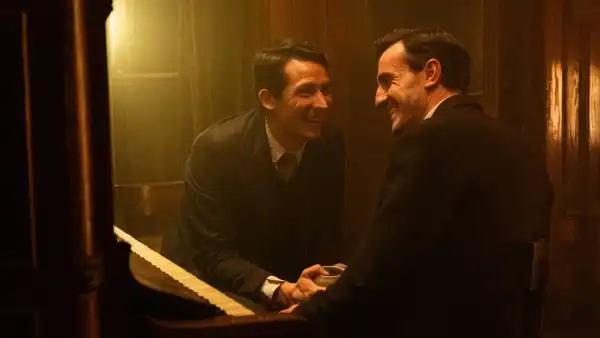
Save this storySave this storySave this storySave this story
Within “The History of Sound,” a recent love story unfolding during and after the Great War, ardor remains intensely intimate, even more so than you might anticipate. Affection and yearning aren’t merely conveyed via the heated strength of bodies entwined; the main pair are stirred, and drawn close, by moments of gentle melodic accord, established upon a bedrock of comparable high sensitivity, polished discernment, and specialized acumen. An early, pivotal scene unfolds in 1917, featuring Lionel Worthing (Paul Mescal), a vocal student at the New England Conservatory, enjoying drinks with companions. In an instant, amidst billows of tobacco smoke and chatter, he discerns a melody he knows: “Across the Rocky Mountain,” an aged folk song he picked up during his upbringing on a Kentucky farm. It’s not exactly a tune heard every day in a Boston pub, and Lionel takes immediate interest in its singer: David White (Josh O’Connor), another student at the conservatory.
What transpires subsequently is essentially infatuation upon initial hearing. We observe two youthful figures connecting over a mutual zeal for American folk music; such songs, arising from provincial oral traditions distinct from their academic world, appear veiled in obscurity. David, blessed with O’Connor’s pixie-like, playful smile, comes across as an instinctive character and able juggler: he’s able to sing, play the keys, and suspend a cigarette from his mouth with roguish charm. Lionel presents as more reserved, yet Mescal—observing from behind delicate spectacles that seem to obscure and amplify his appeal—deploys his character’s composure to subtly potent effect. When Lionel, encouraged by David, performs “Silver Dagger,” a folk tune centered on a young woman striving to honor her mother’s distrust of men, his voice reverberates throughout the hazy, now hushed bar with a luminescence that borders on the transcendent.
Lionel’s vocal gift comprises one of two talents he has fostered since boyhood. The other is that Lionel possesses the ability to perceive sound as visual. In an introductory narration, an older version of Lionel, embodied by Chris Cooper, recounts his astonishment upon discovering that few others can. “I believed everyone could see sound. Yellow for D,” he states. “And taste. My father would play a B-minor, and my mouth turned bitter.” For the majority, sound remains invisible, and the movie hints that Lionel and David’s instant draw toward each other is primarily imperceptible, save for those aligned to the same frequency. As the two descend into bed, and into the core of a physically, emotionally, and intellectually stimulating romance, it’s as though their passion for music, an inherently isolating pursuit, had shielded them against the perils of public exposure. It’s not that their love lacks the courage to declare itself; it’s that only a few would recognize the declaration if made, or even begin to grasp its language.
While Lionel’s sensory perception is never explicitly labeled onscreen, he experiences what is broadly categorized as synesthesia, wherein particular stimuli generate multiple sensory responses. (Robin Wright, from The New Yorker, drawing from her own experiences, depicted the condition as “a form of neurological crossover.”) Numerous films have conjured synesthesia, sometimes unintentionally, other times by explicitly trying to recreate its consequences. Within the 1940 Disney classic “Fantasia,” an ensemble of animators sought visual counterparts for the contours of classical music—largely through descriptive narrative imagery but also via inventive bursts of pure abstraction. Paul Thomas Anderson’s “Punch-Drunk Love,” from 2002, showcases lyrical interludes wherein a chromatic band saturates the screen, with each ascendant note of Jon Brion’s score seemingly tied to a different hue.
Within “The History of Sound,” the South African director Oliver Hermanus expresses limited curiosity regarding such bold displays of cinematic expressionism. The film contains a spare, austere elegance. Its most arresting scenes depict forests and farmland, which the cinematographer Alexander Dynan captures in a frigid, faded spectrum characterized by pale grays and arid browns. If intense or vibrant hues are present, they exist locked inside Lionel’s consciousness—a vault that, despite snippets of voice-over, Hermanus remains reluctant to easily invade. His carefulness extends to his rendering of David and Lionel’s relationship. The men’s initial intimacy involves playful foreplay—David, acting as an innate prankster, sprays water onto Lionel’s face—and an almost transactional proposal (“Come on”), succeeded by a brief, dignified transition to the following morning.
There’s minimal indication of wavering, peril, or jeopardy, which feels initially welcome; it’s apparent that Hermanus hopes for his figures to experience life and affection, at least in the present, without trepidation. Nevertheless, the romance also unfolds with a peculiar absence of sensual exploration and pervasive fervor—and positively none of the spark that distinguished O’Connor’s performance in “God’s Own Country” (2017) or Mescal’s in “All of Us Strangers” (2023), to invoke two gay romances of heartbreaking, persistent emotional impact. In “The History of Sound,” David and Lionel enter and exit each other’s embrace with an almost routine brevity, as if even their romantic pinnacles were a pleasure too insulated and rarefied for audience engagement. Eventually, the First World War brings their academic pursuits and their bond to an abrupt conclusion: David is conscripted and dispatched overseas, and Lionel, exempted due to poor vision, goes back to Kentucky to assist his parents (Raphael Sbarge and Molly Price) with the family’s farming. Yet, even here, the pang of the lovers’ separation emerges only as a muffled sense of despondency. The camera retains its external perspective, observing from afar.
When “The History of Sound” debuted earlier this year at Cannes, commentators drew comparisons, predominantly unfavorable, to “Brokeback Mountain,” Ang Lee’s 2005 drama. These comparisons may ultimately reveal less about any weaknesses in Hermanus’s film than they do about the enduring power of Lee’s, alongside a disheartening dearth of any other prominent gay romance achieving parallel cultural importance. All the same, the reasons for these parallels are self-evident. To start with the surface-level similarities, both films involve skillful narrative expansions: “Brokeback Mountain” originated from an Annie Proulx short story, and “The History of Sound” was tailored, by Ben Shattuck, from his own short story bearing the same title. Both films generated enthusiasm by casting two celebrated and favored male performers as romantic leads; concerning Hermanus’s work, the collaboration between Mescal and O’Connor stirred a resurgence of debate around the longstanding but increasingly frowned-upon practice of straight actors playing gay characters—a critique that Heath Ledger and Jake Gyllenhaal, the performers in “Brokeback Mountain,” did not confront as acutely.
The deeper connection between the two films resides in their shared appreciation of love as something most completely voiced, encountered, perfected, and liberated while immersed in nature, distanced from societal scrutiny. In 1919, David, who is now back from the war and teaching in Maine, asks Lionel to accompany him that winter on a university-sponsored exploration project to document folk melodies. Together, they set off by foot through the Maine woods, employing an Edison phonograph and an array of wax cylinders to safeguard the voices and songs they discover along their path.
The recording segments stand out among the film’s more memorable, remaining aware of both the strength of the music and the peculiar, sacred closeness that can materialize swiftly between strangers. A particularly emotive encounter unfolds on Malaga Island, home to a formerly enslaved population where David and Lionel capture a young woman, Thankful Mary Swain (Brianna Middleton), singing the hymn “Here in the Vineyard.” As a song of refuge, its beauty strikes a notably bleak, ironic tone, given that the residents of Malaga face imminent eviction at the hands of Maine’s land-hungry governor. (Historically, this expulsion transpired somewhat earlier, in 1912.)
The young men’s inability to prevent this injustice instigates a fleeting rift between them, and while the eviction occurs off-screen, the nod to anti-Black aggression comes across as more than a casual detail. Hermanus, now forty-two, matured in Cape Town, originating from a mixed-race family that experienced and protested against apartheid. An understanding of both racial and sexual injustice has colored his preceding works: in “Beauty” (2011), a middle-aged husband and father’s hidden desires break out into terrifying violence; “Moffie” (2021) centers on a gay South African teenager completing mandatory military duty during the early nineteen-eighties. Throughout both films, with unrelenting observational precision, Hermanus exposed the interwoven biases of the apartheid period while confronting homophobia and white supremacy as expressions of the same oppression.
The considerable divergence following that came in “Living” (2022), a reimagining of “Ikiru,” Akira Kurosawa’s 1952 masterpiece revolving around a lifelong office worker committed to fully embracing his final days. In certain respects, that work reads as a truer companion to the new film than Hermanus’s earlier dramas of anguished queer yearning. The spiritual and philosophical themes highlighted by “Living”—centering on the inherent privacy of a person’s existence, along with the challenge of knowing how to utilize the time allotted—linger sadly over David, who faced trauma in childhood and suffers additional hardship amid the war. They likewise occupy Lionel, who, after the Maine journey, finds himself once more unhappily estranged from David and subsequently casts himself adrift. He briefly sojourns in Rome and Oxford, wherein esteemed musical positions and tempting romantic prospects lie in wait, but none can replicate the sense of professional and romantic fulfillment he gleaned from his song-collecting expedition with David.
Mescal filmed this work promptly following “Gladiator II,” and, to his merit, his performance contains no indication of vengeful showiness. Lionel may exhibit a certain lack of romantic passion, but Mescal’s lighthearted vigilance and contemplative calmness render the character an affable presence, even as the filmmaking ultimately yields to inertia and the great, defining affection of Lionel’s existence fades into the haze of memory. On the other hand, a kind analysis of “The History of Sound” may suggest that the film is essentially a memory, and has been enveloped in that haze from the outset. This may clarify why Lionel’s experiences, as presented, already evoke lovely yet muffled memories—carefully arranged for the lens and, notwithstanding all of Lionel’s synesthesia, devoid of their immediate sensory impact. ♦
Sourse: newyorker.com






